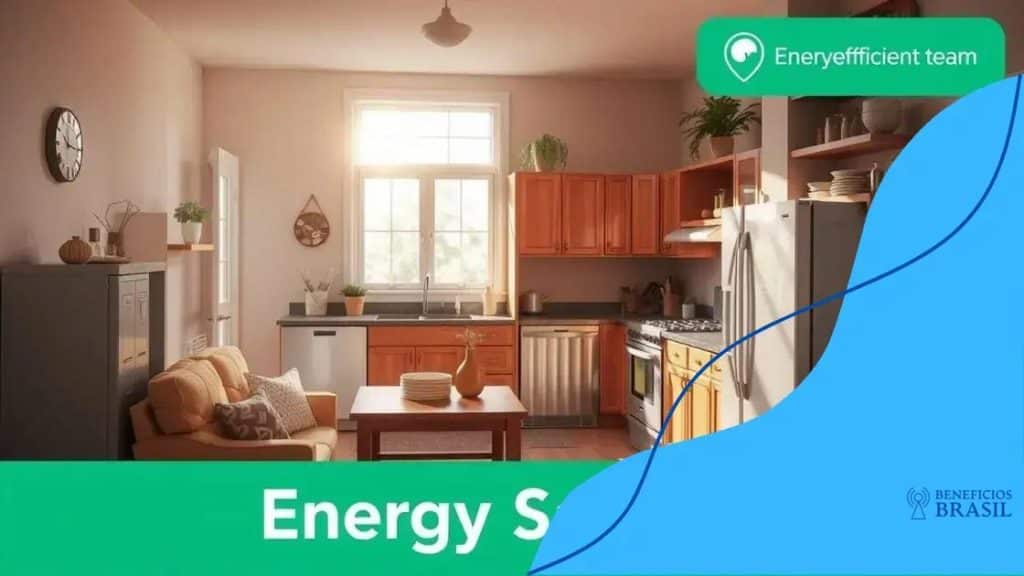Low-Income Energy Assistance (LIHEAP): Tips to cut your bills

Low-Income Energy Assistance (LIHEAP) helps eligible families pay their energy bills, assisting with heating and cooling costs while providing resources for energy efficiency and financial support.
Low-Income Energy Assistance (LIHEAP) is a vital program that helps families manage energy costs. Are you struggling with high utility bills? There are practical approaches available to lighten that burden.
Understanding LIHEAP and its benefits
LIHEAP stands for Low-Income Home Energy Assistance Program, which helps eligible households manage their energy costs. By understanding how LIHEAP works, families can significantly cut down their utility expenses.
The program provides assistance with heating and cooling costs, ensuring that vulnerable populations stay safe and comfortable during extreme temperatures. This support extends beyond just bill payments; it includes education and resources for energy efficiency.
Key Benefits of LIHEAP
The benefits of LIHEAP are extensive and can have a lasting impact on a household’s financial well-being. Here are some key advantages:
- Access to financial aid for energy bills.
- Assistance in maintaining essential heating and cooling services.
- Educational resources to promote energy-saving practices.
- Connections to other local resources and programs for additional support.
Understanding the eligibility criteria is crucial for those who wish to apply for this support. Generally, you must meet income guidelines, which vary by state. LIHEAP helps both renters and homeowners, which makes it a vital resource for many.
Many families find that applying for LIHEAP is a straightforward process. You can often initiate your application through your local community action agency or state LIHEAP office. Make sure to have necessary documentation ready, such as proof of income and identification.
Additional Resources
In addition to financial assistance, LIHEAP also connects applicants with resources that can improve energy efficiency in their homes. These can include:
- Home energy audits to identify areas for improvement.
- Free or low-cost repairs to heating and cooling systems.
- Information on weatherization programs to help insulate homes.
By leveraging LIHEAP, families are not only supported during financial hardships but are also empowered to make changes that lead to long-term savings.
How to qualify for LIHEAP assistance

Understanding how to qualify for LIHEAP assistance is essential for families in need of help with energy costs. The eligibility requirements can vary depending on your state, but there are some common factors that most applicants will need to consider.
Your household income is a key part of the qualification process. Generally, your income must fall below a certain percentage of the federal poverty level. Additionally, household size will also play a significant role in determining eligibility. It’s important to gather your financial documents to prove your income.
Eligibility Criteria
To qualify for LIHEAP, households should meet the following criteria:
- Be a resident of the state in which you apply.
- Have a gross income that meets the required limits.
- Be responsible for paying heating or cooling costs.
- Provide necessary documentation, such as proof of income or identification.
Every state has specific guidelines for LIHEAP, so checking with your local LIHEAP office can provide the most accurate information. Understanding the exact requirements will help you prepare your application correctly.
Applications are typically available online or through community action agencies. When completing your application, ensure all required documentation is included. Missing documents can delay the process. After submitting, it usually takes time for your application to be reviewed and approved.
Additional Considerations
Some states may offer priority for vulnerable groups, including the elderly and disabled. If you fall into these categories, mention it in your application, as it can enhance your chances of receiving assistance. Furthermore, annual deadlines for applications may vary, so stay updated on when to apply.
Once qualified, LIHEAP can provide significant benefits, including support for heating bills in winter and cooling costs in summer. Using LIHEAP resources means you can gain peace of mind during challenging financial times.
Steps to apply for LIHEAP programs
Applying for LIHEAP programs can seem daunting, but knowing the steps can simplify the process. Following these guidelines will help ensure that your application goes smoothly.
The first step is to gather all necessary documents. You will typically need proof of income, identification, and details about your housing situation. Having everything organized before you start will save time and stress.
Step-by-Step Application Process
Here is a simple breakdown of the steps involved in applying:
- Check Eligibility: Verify if your household meets the income requirements.
- Gather Documentation: Assemble proof of income, identification, and any other required documents.
- Fill Out the Application: Complete the application form accurately. This is often available online or at local agencies.
- Submit Your Application: Turn in your application and documents by mail or in person to your local LIHEAP office.
Once submitted, you might receive confirmation from your local agency. It’s important to keep track of your application status and follow up if necessary. Patience is key, as it may take some time to process.
Tips for a Successful Application
To increase your chances of approval, consider these helpful tips:
- Ensure all documents are complete and accurate.
- Meet deadlines for application submissions.
- Provide additional information if requested promptly.
- Stay informed about any program updates or changes.
After your application is approved, you will receive a notification regarding the level of assistance you will receive. Being proactive and knowledgeable can make applying for LIHEAP programs much more manageable.
Tips for reducing utility bills effectively

Reducing utility bills is crucial for families looking to save money each month. There are several practical steps you can take to make your home more energy efficient without sacrificing comfort.
One effective way to lower your bills is by improving your home’s insulation. Proper insulation keeps your home warm in the winter and cool in the summer, reducing the need for heating and cooling systems.
Practical Tips for Lowering Utility Bills
Here are some tips that can help you cut down on those bills:
- Adjust Your Thermostat: By lowering your thermostat in winter and raising it in summer, you can save money.
- Use Energy-Efficient Appliances: Upgrade to appliances that have the ENERGY STAR label, as they use less electricity.
- Seal Leaks: Check for leaks around windows and doors. Sealing these gaps can prevent energy loss.
- Unplug Devices: Unplug electronics when not in use. Many devices still consume energy when plugged in.
Using natural light can also help reduce electricity costs. Keep curtains open during the day to let sunlight in and rely less on artificial lighting.
Consider Alternative Energy Sources
Exploring alternative energy opportunities, such as solar panels, can lead to long-term savings. While the upfront costs may be higher, they can significantly lower your utility bills over time. Additionally, some states offer incentives for installing solar energy systems.
Regular maintenance of heating and cooling systems is vital as well. Cleaning or replacing filters can ensure that these systems run efficiently, using less energy. Schedule annual check-ups with a professional to keep your systems in top shape.
These practical steps not only help in lowering your bills but also contribute to a more sustainable environment by using energy wisely. Making small changes can result in significant savings over time.
Resources for additional support and information
Finding additional resources for support can make a big difference for families seeking help with energy costs. Numerous organizations and programs exist to assist low-income households with their utility bills.
Your first step is to connect with local organizations. Community action agencies often provide information about LIHEAP and other assistance programs available in your area. They can guide you through the application process and offer valuable resources.
National Resources
In addition to local resources, several national organizations provide support:
- National Energy Assistance Referral (NEAR): This service can help you find state-specific resources and local programs.
- Energy Assistance Program (EAP): A program that offers financial aid for low-income households struggling to pay energy bills.
- U.S. Department of Health and Human Services (HHS): The HHS website provides information about energy assistance initiatives, including LIHEAP.
- 211: By dialing 211, you can access a range of social services, including energy assistance programs in your community.
Utilizing these national resources ensures you have comprehensive support as you explore options to lower your utility costs.
Finding Local Support
In addition to national programs, look for local nonprofits and charities that offer assistance. Many cities have organizations dedicated to helping families in need. These might include fuel assistance programs, grants for energy-efficient home upgrades, and educational resources that teach families about saving energy.
It’s important to stay informed about deadlines and eligibility criteria for these resources. Most organizations will have dedicated websites or contact numbers where you can get real-time updates and assistance. Regular communication can help you navigate the available options more efficiently.
Consider joining community forums or groups that focus on energy assistance. These platforms can connect you with others facing similar challenges and provide tips and shared experiences that can lead to additional resources.
FAQ – Frequently Asked Questions about LIHEAP Assistance
What is LIHEAP?
LIHEAP stands for Low-Income Home Energy Assistance Program, which helps low-income families pay their energy bills.
Who is eligible for LIHEAP assistance?
Eligibility typically depends on your household income, family size, and whether you are responsible for energy costs.
How do I apply for LIHEAP assistance?
You can apply through your local community action agency or state LIHEAP office, usually by completing an application and providing necessary documents.
What resources are available for additional support?
Many local and national organizations provide resources, including financial aid, energy-efficient tips, and educational programs to assist families in need.
